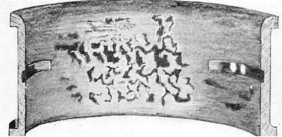Chapter 3—ENGINE MAINTENANCE
Another source of trouble during installation
is due to the interchanging of the upper and lower
shells. The installation of a plain upper shell in
place of a lower shell, which contains an oil
groove, completely stops the oil flow and leads
to early bearing failure. The resulting damage not
only may ruin the bearing but may also extend
to other parts, such as the crankshaft connecting
rod, piston, and wrist pin.
8. Failure to follow recommended procedures
in the care of lubricating oil. Lack of proper
amount of lubricating oil will cause the
overheating of a bearing, causing its failure (see
figure 3-22). In large engines, the volume of the
lubricating oil passages is so great that the time
required to fill them when starting an engine could
be sufficient to permit damage to the bearings.
To prevent this, separately driven lubricating oil
priming pumps are installed, and by their action,
the oil is circulated to the bearings before an
engine is started. Priming pumps should be
secured prior to starting the engine when the
prescribed pressure has been obtained.
circulation, and sufficiently low to prevent
excessive oxidation of the lubricating oil. Nor-
mally, the manufacturer’s technical manual
should be followed as to the correct lubricating
oil temperature to maintain. However, if no
manual is available, the temperature of the oil
leaving the engine should be maintained between
160° and 200°F. When possible, oil must be
analyzed at recommended intervals to determine
its suitability for further use. In addition, regular
service of oil filters and strainers must be main-
tained, and oil samples must periodically be drawn
from the lowest point in the sump to determine
the presence of abrasive materials or water. The
lube oil purifier should be used in accordance with
required procedures. Strict adherence to recom-
mended practices will reduce the failure of bear-
ings and other parts because of the contaminated
oil or insufficient supply of clean oil.
FRICTIONLESS BEARINGS
Maintenance of recommended oil pressures is
essential to ensure an adequate supply of oil at
all bearing surfaces. Refer to the oil pressure gage
as it is the best source of operational information
to indicate satisfactory performance.
Figure 3-23 lists the troubles that may be
encountered with all types of (antifriction fric-
tionless) bearings.
Use Navy-approved, low-corrosive lubricating
oils at recommended oil temperatures. Recom-
mended temperatures have been determined by
extensive tests in laboratory and in service.
They are sufficiently high to assure satisfactory
Since dirty bearings will have a very short serv-
ice life, every possible precaution must be taken
to prevent the entry of foreign matter into bear-
ings. Dirt in a bearing which has been improperly
or insufficiently cleaned may be detected by noise
when the bearing is rotated, by difficulty in
rotating, or by visual inspection. Do not discard
an antifriction bearing until you have definitely
established that something in addition to dirt has
caused the trouble. You may determine this by
properly cleaning the bearing.
Spalled or pitted rollers or races may be first
recognized by the noisy operation of the bearing.
Upon removal and after a very thorough clean-
ing, the bearing will still be noisy when rotated
by hand. (Never spin a frictionless bearing with
compressed air.) Roughness may indicate spall-
ing at one point on the raceway.
Figure 3-22.—Overheated bearing.
121.6
Pay particular attention to the inner surface
of the inner race, since it is here that most sur-
face disintegration first occurs. Since pits may be
covered with rust, any sign of rust on the rollers
or contact surfaces of the races is a probable
indication that the bearing is ruined.
3-35

